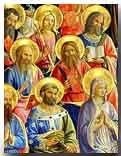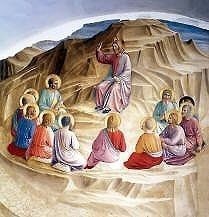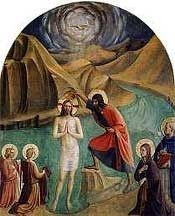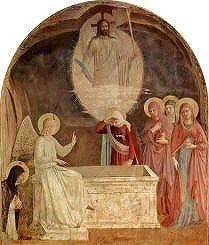Fra Angelico Gallery of High Resolution Royalty Free Images. The outstanding Biblical paintings of the great painter Fra Angelico.
Always Royalty Free
High Resolution Bible Art |

The Annunciation, 1430
Choose images for full size |
"The Annunciation"
Luke 1
Fra Angelico painted this "Annunciation" in the upper corridor of the cloisters of San Marco, Florence. Of it Taine remarks, "Such immaculate modesty, such virginal candor! By her side Raphael's Virgins are merely vigorous peasant girls." This painting reflects clearly the pious nature of the artist, who was diligently seeking in pictures like this to express the inner life of the adoring soul.
At eventide the Virgin is shown seated in an open loggia, reverently receiving the message brought by the angel who has just lighted bows to her and designates her the chosen one of God. |
Fra Angelico 1387 – 1455
Ranking among the great leaders of the Florentine Renaissance, in Fra Angelico the artist and the saint worked in such perfect harmony that we are rarely conscious of any effort on the part of the latter to dominate the former. And it is in this fact that one of the greatest secrets of his success lies. He painted the kind of subjects that he liked best to paint, and, as John Addington Symonds observes, "So essential a part of him were his artistic qualities that the fervor of his religious emotion scarcely ever marred the decorative character of his work." |
Vasari, whose description of Fra Angelico has impressed itself upon a dozen generations of readers, calls him a primary artist who happened to be a saint. To say, as some do, that Fra Angelico was more interested in the matter of his theme than in its representation is only to say what is true of every great Florentine painter of the Renaissance. In Venice there was a love of painting for its own sake. The great Florentines, on the other hand, were very much more than painters. They were sculptors, poets, men of science, theologians, archaeologists and humanists; and at times their desire to record mere facts of the natural world, or to teach some theological or philosophical dogma, predominated over all purely artistic impulses. Fra Angelico, in whom we have observed the artist and saint in perfect accord, was an exception that proved the rule. |
It is related of Fra Angelico, whose baptismal name was Guido and who was born at Vicchio, near Florence, Italy, in 1387, that being invited to breakfast by Pope Nicholas V he had scruples of conscience as to eating meat without the permission of his prior, not considering that the authority of the pontiff superseded that of the prior. Such was his simple earnestness of purpose.
Guido probably would have been content to follow the profession of a painter alone had it not been for the great Italian preacher and scholar, Giovanni Dominici, a Dominican friar, who, early in the fifteenth century, established a monastery at Fiesole to which Guido sought and obtained admission at the age of twenty. A year later he changed his name to Giovanni, being known as Fra Giovanni da Fiesole. It was not until after his death and beatification that he was called Angelico, the Angelic. |
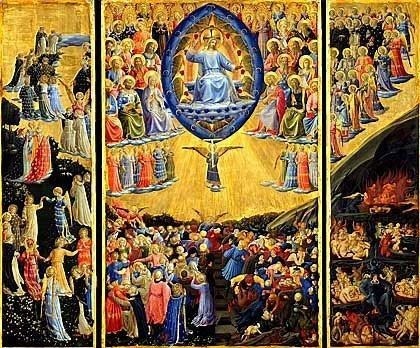
The Last Judgment Winged Altar by Fra Angelico
Choose images for High Resolution or Enlarge
Buy the Print
Choose from 9 sizes |
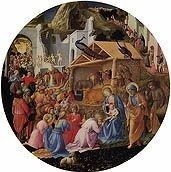
Adoration of the Magi
Fra Angelico, 1445 |
In the summer of 1435, Fra Angelico removed from the convent of his order at Fiesole, where he had painted the great "Coronation of the Virgin", now in the Louvre, to the newly renovated Convent of San Marco at Florence, which now contains his "Last Judgment", four great Madonnas and sundry other of his pictures. There, writes Langton Douglas, before the buildings were fairly completed he began to decorate the interior walls of the convent, which in time became a perfect treasure-house of his works. |
The "Crucifixion" which Fra Angelico painted in the chapter-house, is the largest and one of the most important of his achievements. He painted frescos of the chief Dominican saints in the cloisters, and decorated the cloister corridors and walls of the cells with sacred subjects, principally scenes from the life of Christ. Thus occupied for a decade, Fra Angelico was summoned to Rome by Pope Eugenius IV to decorate a chapel adjoining St. Peter's, which was razed less than a century later to make room for the great staircase of the Vatican Palace.
At the age of sixty, he entered upon the crowning achievement of his life – the decoration of the Chapel of Nicholas V in the Vatican, on the walls of which he painted his famous frescos representing scenes from the lives of Sts. Laurence and Stephen.
Fra Angelico disregarded all earthly advantages, and strove to live in simple holiness. He labored continually at his paintings, but, Vasari records, would do nothing dissociated from things holy. He might have been rich, but of riches he took no care. On the contrary, he was accustomed to say that the only true riches was contentment with little. He might have commanded many, but would not do so, declaring that there was less fatigue and less danger of error in obeying than in commanding others.
Estimating Fra Angelico as an artist, Muther says that "when he does not leave his proper sphere, and the problem is to portray tender feelings, a great and silent joy of the heart, a holy ecstasy or tender sadness, his pictures have the effect of the silent prayer of a child." It was his custom to abstain from retouching or improving any painting once finished. He altered nothing, believing, as he said, that such was the divine will. It also is affirmed that he would never take brush in hand until he had first offered a prayer.
In 1455, at sixty-eight, this good man and great painter died in Rome in the historic convent of his order, Santa Maria Sopra Minerva, and was buried near the high altar in the convent church. At the command of Pope Nicholas his effigy was carved upon his marble tomb, together with an epitaph in Latin, composed, it is said, by the pope himself, inspired by the virtues of the holy monk.
Navigation and Searching – Terms of Use – Contact Us
© 2010-2022 Free Christ Images |
